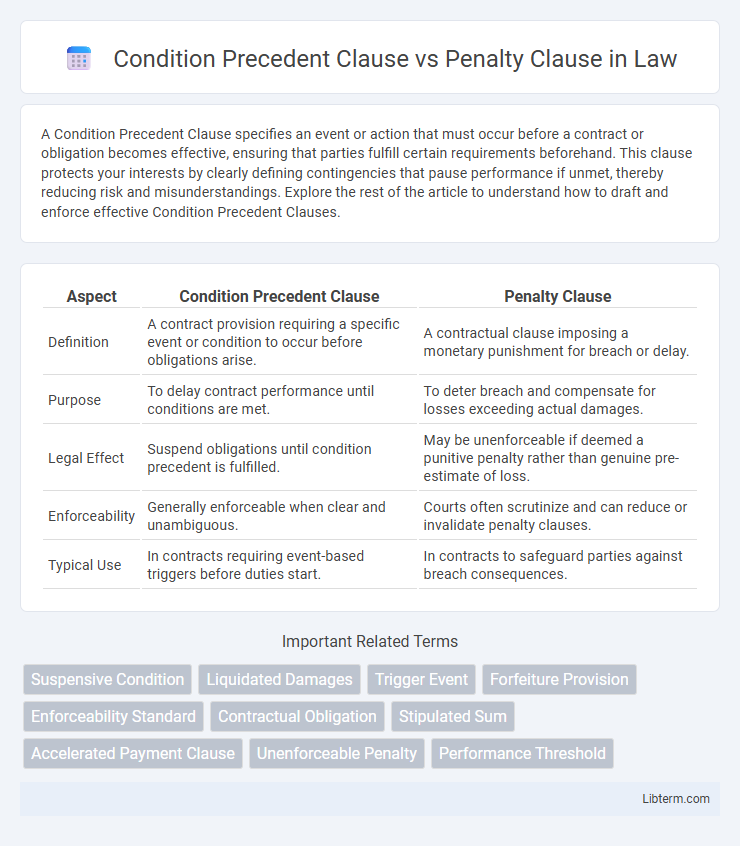A Condition Precedent Clause specifies an event or action that must occur before a contract or obligation becomes effective, ensuring that parties fulfill certain requirements beforehand. This clause protects your interests by clearly defining contingencies that pause performance if unmet, thereby reducing risk and misunderstandings. Explore the rest of the article to understand how to draft and enforce effective Condition Precedent Clauses.
Table of Comparison
| Aspect | Condition Precedent Clause | Penalty Clause |
|---|---|---|
| Definition | A contract provision requiring a specific event or condition to occur before obligations arise. | A contractual clause imposing a monetary punishment for breach or delay. |
| Purpose | To delay contract performance until conditions are met. | To deter breach and compensate for losses exceeding actual damages. |
| Legal Effect | Suspend obligations until condition precedent is fulfilled. | May be unenforceable if deemed a punitive penalty rather than genuine pre-estimate of loss. |
| Enforceability | Generally enforceable when clear and unambiguous. | Courts often scrutinize and can reduce or invalidate penalty clauses. |
| Typical Use | In contracts requiring event-based triggers before duties start. | In contracts to safeguard parties against breach consequences. |
Introduction to Condition Precedent and Penalty Clauses
Condition precedent clauses specify events or actions that must occur before a contractual obligation becomes enforceable, ensuring that parties are not bound until specified conditions are fulfilled. Penalty clauses impose a predetermined financial consequence for breach of contract, discouraging non-performance by setting damages that are often unenforceable if deemed extravagant or punitive. Understanding the distinction is vital for drafting clear contracts that balance enforceability with risk allocation.
Defining Condition Precedent Clauses
A Condition Precedent Clause specifies an event or action that must occur before a contractual obligation becomes enforceable, ensuring performance is triggered only after certain criteria are met. This clause clearly outlines the requirements that delay or suspend duties until the stipulated condition is fulfilled, providing legal clarity on the timing of obligations. Unlike a Penalty Clause, which imposes a punishment for breach, a Condition Precedent Clause controls the existence or commencement of a contractual duty.
Understanding Penalty Clauses
Penalty clauses impose a predetermined financial consequence on a party that fails to perform contractual obligations, serving as a deterrent against breaches rather than merely ensuring compensation. Unlike condition precedent clauses, which set specific conditions that must be met before contractual duties become effective, penalty clauses are designed to enforce strict compliance and penalize non-performance. Courts often scrutinize penalty clauses to distinguish enforceable liquidated damages from punitive measures, emphasizing the clause's reasonableness and proportionality to actual harm.
Key Differences Between Condition Precedent and Penalty Clauses
Condition Precedent Clauses specify events or actions that must occur before a contract or obligation becomes effective, focusing on the timing and fulfillment of specific requirements. Penalty Clauses, by contrast, impose financial or legal consequences for breach or failure to perform contractual duties, serving as a deterrent rather than a trigger. The key difference lies in their purpose: condition precedent clauses control contract activation, while penalty clauses enforce compliance and penalize non-performance.
Legal Implications of Condition Precedent Clauses
Condition precedent clauses determine the occurrence of specific events that must be fulfilled before contractual obligations become enforceable, directly impacting the timing and enforceability of performance. These clauses protect parties by suspending liability until the agreed condition is satisfied, often used in real estate transactions or financial agreements to mitigate risks. Misinterpretation or failure to fulfill conditions precedent can result in contract invalidation or delayed performance, emphasizing the necessity of precise drafting and clear legal intent.
Legal Consequences of Penalty Clauses
Penalty clauses in contracts impose fixed sums as punishment for breach, often deemed unenforceable in many jurisdictions to avoid unjust enrichment or unfair hardship. Courts typically differentiate penalty clauses from liquidated damages, enforcing only those that represent a genuine pre-estimate of loss. Legal consequences of penalty clauses include nullification of the clause, leaving the injured party to seek actual damages through litigation.
Enforceability under Contract Law
Condition precedent clauses are enforceable under contract law as they specify events that must occur before contractual obligations arise, ensuring clarity and mutual consent between parties. Penalty clauses, however, are generally unenforceable in many jurisdictions because they impose disproportionate or punitive damages not reflective of actual losses, contrary to the principle of compensatory damages. Courts typically uphold liquidated damages clauses that represent a genuine pre-estimate of loss, distinguishing them from penalties to maintain fairness and contractual balance.
Common Applications in Commercial Agreements
Condition precedent clauses in commercial agreements specify events or actions that must occur before contractual obligations become effective, ensuring risk mitigation and performance certainty between parties. Penalty clauses impose monetary sanctions or fees for failure to fulfill contractual duties, serving as deterrents against breaches and compensation mechanisms. Commonly, condition precedent clauses are used in financing and merger agreements, while penalty clauses feature prominently in construction contracts and service-level agreements to enforce compliance.
Drafting Tips for Condition Precedent and Penalty Clauses
When drafting a condition precedent clause, clearly define specific conditions that must occur before contractual obligations become effective, using precise language to avoid ambiguity and ensure enforceability. For penalty clauses, state liquidated damages with reasonable estimates of actual loss to prevent them from being deemed punitive and unenforceable by courts. Incorporate explicit timelines and notice requirements in both clauses to streamline dispute resolution and minimize contractual risk.
Case Law Illustrations and Best Practices
Condition precedent clauses require specific conditions to be fulfilled before contractual obligations become enforceable, as illustrated in *Pym v Campbell* (1856) where the contract was void due to unmet conditions. Penalty clauses, often deemed unenforceable, are scrutinized under the *Dunlop Pneumatic Tyre Co Ltd v New Garage & Motor Co Ltd* (1915) test to distinguish them from liquidated damages. Best practices involve drafting clear condition precedent language to avoid ambiguity and ensuring penalty clauses reflect genuine pre-estimates of loss to withstand legal scrutiny.
Condition Precedent Clause Infographic

 libterm.com
libterm.com